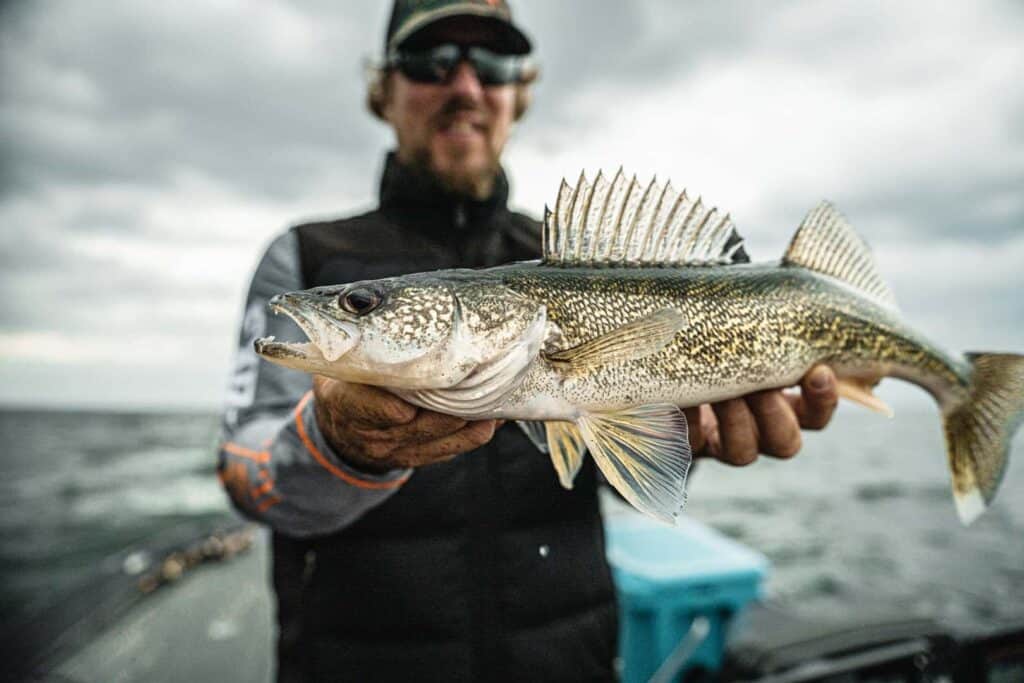Utilizing downriggers for trophy fish involves precise depth control and bait presentation, strategic trolling speeds, and adjusting depths based on temperature and structure to target elusive, deep-dwelling trophy specimens effectively.
Going Deep: Expert Tips for Downrigger Success in the Open Water
Downriggers are a popular tool used in open water fishing to help anglers reach deeper depths and target specific species of fish. They are essentially a device that is attached to a boat and used to lower fishing lines to desired depths. By using a downrigger, anglers can effectively fish in deep waters where fish are more likely to be found.
One of the main benefits of using downriggers for open water fishing is the ability to control the depth at which your bait or lure is presented. This is especially important when targeting species that prefer to stay at specific depths, such as salmon or trout. By using a downrigger, you can precisely position your bait or lure at the desired depth, increasing your chances of success.
Understanding the Mechanics of Downriggers
A downrigger consists of several key components that work together to lower and retrieve fishing lines. The main parts of a downrigger include a boom, a weight, a line release mechanism, and a spool. The boom is the arm-like structure that extends out from the side of the boat and holds the weight and fishing line. The weight is attached to the end of the boom and is used to sink the fishing line to the desired depth.
There are different types of downriggers available on the market, including manual and electric models. Manual downriggers require anglers to manually crank the spool to lower and retrieve the fishing line, while electric downriggers have a motorized spool that does the work for you. Electric downriggers are generally more expensive but offer convenience and ease of use.
Choosing the Right Downrigger for Your Needs
When selecting a downrigger, there are several factors to consider. One important factor is the size of your boat. If you have a smaller boat, you may want to opt for a compact downrigger that won’t take up too much space. On the other hand, if you have a larger boat, you may be able to accommodate a larger downrigger with more features.
Another factor to consider is your fishing style. If you prefer to fish alone or with a small group, a manual downrigger may be sufficient. However, if you often fish with a larger group or prefer the convenience of an electric downrigger, you may want to invest in a motorized model.
There are many different downriggers available on the market, each with its own set of features and price points. Some popular brands include Cannon, Scotty, and Big Jon. It’s important to do your research and read reviews to determine which downrigger is best suited for your needs and budget.
Setting Up Your Downrigger for Optimal Performance
Setting up your downrigger properly is crucial for optimal performance. Here is a step-by-step guide to help you get started:
1. Attach the downrigger to your boat: Most downriggers come with mounting brackets that can be attached to the side of your boat. Make sure the downrigger is securely fastened before proceeding.
2. Attach the boom: The boom should be attached to the mounting bracket and positioned so that it extends out over the side of the boat.
3. Attach the weight: The weight should be securely attached to the end of the boom using a snap or clip.
4. Attach the fishing line: The fishing line should be attached to the line release mechanism, which is typically located on the boom. Make sure the line is securely fastened before proceeding.
5. Adjust the depth: Use the depth counter on the downrigger to determine how much line to let out. This will depend on the depth at which you want to fish and the length of your fishing rod.
6. Lower the weight: Slowly lower the weight into the water, allowing the fishing line to unwind from the spool. Make sure the line is feeding out smoothly and not getting tangled.
7. Adjust the tension: Once the weight is at the desired depth, adjust the tension on the line release mechanism to hold the fishing line in place. This will prevent the weight from pulling the line back up.
8. Start fishing: Once everything is set up, you can start fishing by attaching your bait or lure to the fishing line and letting it out to the desired depth.
It’s important to note that each downrigger may have slightly different setup instructions, so be sure to consult the manufacturer’s manual for specific guidance.
Selecting the Right Lures for Open Water Fishing
When it comes to open water fishing, selecting the right lure is crucial for attracting fish. There are several different types of lures that are commonly used in open water fishing, including spoons, crankbaits, and soft plastics.
Spoons are a popular choice for open water fishing because they mimic the movement of baitfish. They come in a variety of sizes and colors, allowing you to match the hatch and target specific species of fish. Crankbaits are another effective lure for open water fishing, as they can be trolled at various depths and mimic the movement of injured baitfish.
Soft plastics are also commonly used in open water fishing, as they can be rigged in a variety of ways and imitate a wide range of prey species. They can be fished on a jighead or rigged weedless for fishing in heavy cover.
When selecting a lure for open water fishing, it’s important to consider the species you are targeting and their feeding habits. For example, if you are targeting trout that feed primarily on insects near the surface, you may want to use a small fly or insect imitation lure. On the other hand, if you are targeting salmon that feed on larger baitfish, you may want to use a larger spoon or crankbait.
Using Electronics to Find Fish
In addition to using downriggers, anglers can also use electronics to help locate fish in open water. Fish finders are a popular tool used by many anglers to locate fish and determine the depth at which they are holding. Fish finders use sonar technology to send out sound waves and detect objects in the water, including fish.
There are several different types of fish finders available on the market, including standalone units and units that can be integrated with other electronics, such as GPS and chartplotters. Standalone fish finders are typically more affordable and offer basic sonar capabilities, while integrated units offer more advanced features and functionality.
In addition to fish finders, anglers can also use other electronics, such as GPS and chartplotters, to help navigate open water and mark productive fishing spots. GPS allows anglers to mark waypoints and track their position on a map, while chartplotters provide detailed charts of the water and can help identify underwater structures and contours.
Downrigger Fishing Techniques for Different Species
Different species of fish require different techniques when using downriggers. Here are some tips for using downriggers to catch different types of fish:
– Salmon: When targeting salmon with a downrigger, it’s important to present your bait or lure at the right depth. Salmon often feed near the surface or in the top 30 feet of the water column, so you may want to set your downrigger at a shallower depth. Trolling at a slower speed can also be effective for targeting salmon.
– Trout: Trout can be found at various depths depending on the time of year and water conditions. In general, trout tend to prefer cooler water temperatures and may be found deeper in the water column during the summer months. Adjusting your downrigger depth based on water temperature and other factors can help increase your chances of success when targeting trout.
– Walleye: Walleye are often found near the bottom of the water column, so setting your downrigger at a deeper depth can be effective for targeting them. Trolling at a slower speed and using lures that mimic their natural prey, such as minnow imitations, can also increase your chances of success.
– Pike: Pike are aggressive predators that can be found in a variety of habitats, from shallow weedy areas to deeper open water. When targeting pike with a downrigger, it’s important to use larger lures that can withstand their powerful strikes. Trolling at a faster speed can also be effective for triggering a reaction bite from pike.
Adjusting Your Downrigger Depth for Optimal Results
Adjusting your downrigger depth is crucial for optimal results when fishing in open water. The depth at which you set your downrigger will depend on several factors, including the species you are targeting, water temperature, and the presence of underwater structures or baitfish.
One way to determine the optimal depth is to use a fish finder or other electronics to locate fish and determine their depth. By marking fish on your fish finder and adjusting your downrigger depth accordingly, you can increase your chances of success.
Water temperature is another important factor to consider when adjusting your downrigger depth. Different species of fish have different temperature preferences, so adjusting your downrigger depth based on water temperature can help you target the right species.
In addition to fish finder and water temperature, it’s also important to consider the presence of underwater structures or baitfish when adjusting your downrigger depth. Fish are often found near underwater structures, such as drop-offs or weed beds, so setting your downrigger at the right depth can help you target these areas.
Trolling Speed and Direction for Successful Downrigger Fishing
Trolling speed and direction can greatly affect your downrigger fishing success. The speed at which you troll will depend on the species you are targeting and their feeding habits. In general, a slower trolling speed is often more effective for targeting species that feed on slower-moving prey, such as trout or salmon. On the other hand, a faster trolling speed can be effective for triggering a reaction bite from aggressive predators, such as pike or muskie.
The direction in which you troll can also affect your downrigger fishing success. When trolling with a downrigger, it’s important to troll in a straight line to ensure that your bait or lure is presented at the desired depth. Trolling against the current or wind can help you maintain a straight line and prevent your lines from tangling.
Tips for Maintaining and Storing Your Downrigger
Proper maintenance and storage of your downrigger is important for extending its lifespan and ensuring optimal performance. Here are some tips for maintaining and storing your downrigger:
– Rinse your downrigger with fresh water after each use to remove any salt or debris that may have accumulated.
– Check the moving parts of your downrigger regularly for signs of wear or damage. Replace any worn or damaged parts as needed.
– Lubricate the moving parts of your downrigger regularly to ensure smooth operation.
– Store your downrigger in a cool, dry place when not in use to prevent rust or corrosion.
– Remove the weight from your downrigger when storing it to prevent strain on the boom and other components.
Safety Precautions and Considerations for Open Water Downrigger Fishing
When using a downrigger for open water fishing, it’s important to take certain safety precautions to ensure a safe and enjoyable experience. Here are some safety tips to keep in mind:
– Always wear a life jacket or personal flotation device (PFD) when fishing in open water. This is especially important when using a downrigger, as there is a risk of falling overboard.
– Be aware of your surroundings and other boaters in the area. Avoid crowded areas and maintain a safe distance from other boats.
– Check the weather forecast before heading out on the water. Avoid fishing in rough or stormy conditions, as this can be dangerous.
– Familiarize yourself with the rules and regulations of the body of water you are fishing in. This includes knowing the speed limits, fishing seasons, and any special regulations that may apply.
– Let someone know where you are going and when you expect to return. This is especially important if you are fishing alone.
Conclusion:
Downriggers are a valuable tool for anglers who enjoy open water fishing. They allow anglers to reach deeper depths and target specific species of fish with precision. By understanding the mechanics of downriggers, choosing the right one for your needs, and setting it up properly, you can increase your chances of success on the water.
Additionally, using the right lures, utilizing electronics to find fish, and employing different techniques for different species can further enhance your downrigger fishing experience. Remember to always prioritize safety and take proper precautions when using a downrigger in open water. So why not give downrigger fishing a try? It may just become your new favorite method for catching fish in open water.
Originally posted 2024-03-10 11:35:16.





